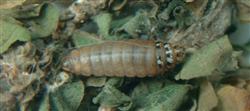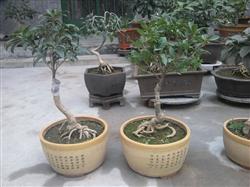Which are the symptoms of sweet-scented osmanthus brown spot

The pathogen of sweet-scented osmanthus brown spot is Cercospora oleifera. It often happens in Hangzhou and other places. Sweet-scented osmanthus brown spot is a very common disease, which mainly infects leaves, seriously leads to defoliation of the whole plant, and affects flowering and ornamental. It often happens in Hangzhou and other places. Symptoms and characteristics of the injured leaves began to appear small macula, and then gradually changed into tawny to grayish brown, the disease spot is nearly round or irregular, or polygonal spots due to the limitation of leaf veins. The lesion is 2mm in diameter and has a yellow halo outside. The disease department produces black mildew spots in wet weather, which are the conidiophores and conidia of the pathogen. The pathogen of sweet-scented osmanthus brown spot overwintered on diseased plants and fallen leaves by mycelium and became the source of infection at the beginning of the next year. Conidia are produced in late March every year and begin to infect. Conidia are transmitted by airflow and raindrops and can invade directly or from wounds and natural orifices. Old leaves are more susceptible than young leaves. Brown spot occurred from April to October and subsided after November. High temperature and humidity are beneficial to the disease. There are differences in resistance among varieties. generally speaking, the disease resistance of Dangui is stronger than that of Jin Gui and Yingui. Control methods: (1) pruning in winter to remove diseased leaves and remove diseased leaves, and centralized burning; (2) at the beginning of May, spray 1 ∶ 2 ∶ 100cm 200 Bordeaux solution, and then spray 50% benzoate 1000 to 1500 times or azinamide 1000 times or 70% methyl topiramate 1000 times. Click to get more sweet-scented osmanthus planting techniques
- Prev

How to cut sweet-scented osmanthus trees?
The larvae spit silk to decorate the leaves, bark fragments and so on to create protective sacs, foraging for mesophyll and leaving veins. The injured leaves are porous, which seriously eats all the leaves on the whole tree and can gnaw on the bark. The growth of sweet-scented osmanthus trees was seriously affected. Control methods: remove the protective capsule, reduce the source of insects, and eliminate the overwintering larvae. Protect the predator's umbrella skirt.
- Next

What are the main diseases and insects of sweet-scented osmanthus?
Potted sweet-scented osmanthus often blooms rarely or does not bloom for a long time. How to make sweet-scented osmanthus blossom more, flowers fragrant, need to master the following main links: variety selection: different varieties of sweet-scented osmanthus, flowering time is not the same. If laurel, four seasons laurel and so on are early flowering varieties, there are several flowering characteristics in a year, some.
Related
- Fuxing push coffee new agricultural production and marketing class: lack of small-scale processing plants
- Jujube rice field leisure farm deep ploughing Yilan for five years to create a space for organic food and play
- Nongyu Farm-A trial of organic papaya for brave women with advanced technology
- Four points for attention in the prevention and control of diseases and insect pests of edible fungi
- How to add nutrient solution to Edible Fungi
- Is there any good way to control edible fungus mites?
- Open Inoculation Technology of Edible Fungi
- Is there any clever way to use fertilizer for edible fungus in winter?
- What agents are used to kill the pathogens of edible fungi in the mushroom shed?
- Rapid drying of Edible Fungi

